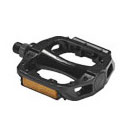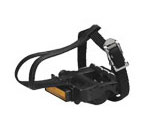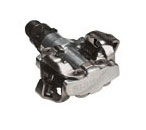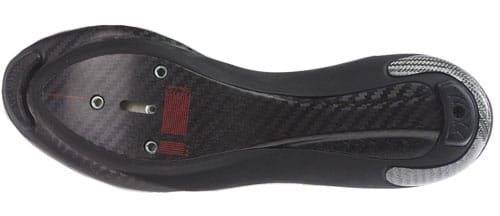
-

Cycling shoes aren't your typical athletic footwear, and most aren’t designed for walking more than short distances. However, the difference they make in your pedaling efficiency is noticeable.
Road Cycling Shoes
Road bike shoes typically have a smooth, extremely rigid sole made of composite or carbon fiber. This makes road shoes poor for walking in. Road cycling shoes are designed to be lightweight, rigid and breathable, and usually include hook-and-loop straps. All road shoes should be compatible with 3-hole road cleats.
Mountain Bike Shoes
Mountain biking shoes offer more tread and may have a slightly less rigid sole to help navigate off-road terrain, but still aren’t ideal for walking more than a few yards at a time. MTB shoes typically have very aggressive tread for scrambling up steep, slippery trails. All MTB shoes should be compatible with 2-hole cleats.
Downhill Shoes and BMX Shoes
Downhill bike shoes and BMX shoes are much more like skate shoes, except with a slightly stiffer sole. The flat outsole and grippy tread pattern make them ideal counterparts to flat pedals.
Indoor Cycling Shoes (Spinning Shoes)
If a spinning class is part of your regular workout routine and you use clipless pedals on your indoor bike, you may want to look for cycling shoes with recessed cleat mounts. Since the cleats don't protrude from the sole, you can easily walk to and from class. Plus, the recessed cleats won't scratch hardwood floors or tile.
-

Cycling Shoe Fit
Your cycling shoes should feel slightly tighter than regular athletic shoes, but not so tight that they interfere with blood circulation. Be sure to allow for a little room in the toe box. The heel cup of your cycling shoe should be snug enough to hold your heel in place through the entire pedal rotation, and there should be even pressure on the instep when the shoe is laced and you are pressing on the ball of the foot.
Cycling Shoe Construction
Your cycling shoes should be lightweight and durable. Most cycling shoes have a composite outsole. High-end road bike shoes may have a carbon fiber sole, which provides maximum stiffness and weight savings. Combination composite and carbon soles offer similar benefits.
Weather Protection
Most cycling shoes are designed to provide ample ventilation to keep your feet cool and dry. However, most bike shoes are not waterproof. If you ride in cold or rainy conditions, you may need additional weather protection. Cycling overshoes that slide over the outside of your bike shoes are a good way to protect feet from penetrating moisture and cold.
Cycling Socks
Avoid wearing cotton socks for rigorous rides, as they don’t manage moisture well. Cycling socks are typically made with materials like moisture-wicking polyester and merino wool, which help feet breathe and stay dry.
-
Flat Pedals

Flat pedals, also called platform pedals, are basically any flat pedal without a cage. Platforms are usually made of either aluminum or steel, although less expensive models can be made of plastic. Flats range from very basic to high-end downhill models. The major advantage of flat pedals is that you can use them with just about any pair of shoes, and they don't require any special skill to use.
Toe Clips (Cage Pedals)

Just a few decades ago, flat pedals with cages were called “toe clips,” and were the only option for cyclists seeking added pedaling efficiency until the invention of modern “clipless” pedals in the mid-1980s. Toe clips feature a plastic cage that surrounds the front of the foot and has adjustable straps to keep the foot securely in place. Toe clips can be a good choice for beginners because they are relatively inexpensive and don’t require special bike shoes. Cage pedals provide improved performance by increasing the pedaling power on the upstroke as well as the downstroke. The drawback, however, is that the straps frequently need to be adjusted, and getting your feet in and out can be tricky until you get accustomed to using them.
Clipless Pedals

The name “clipless pedals” can be confusing to new riders because the action of using them seems analogous to “clipping in.” Rather than relying on large plastic cages (traditionally called clips), clipless pedals contain a spring mechanism that clamps onto a special cleat, which is mounted to the bottom of a bike shoe. The cleat is typically made of metal or hard composite. Clipless pedals are much smaller than platform pedals and are used with shoes designed specifically for cycling (in other words, regular shoes will not work with clipless pedals). Every pair of clipless pedals should come with a corresponding set of cleats, which must be manually installed on the sole of your bike shoes using small screws (which should also be included). Road pedals are larger and generally only have a spring mechanism on one side. Mountain bike pedals tend to have a dual-sided mechanism for easier entry and exit on the trail.
Below are some of the most common types of clipless pedal systems:
Two-Hole System (MTB)

The image above shows what a typical mountain bike sole looks like, including the cleat mounting bracket which will accommodate two-hole cleats. (Most brackets have two parallel sets of mounting holes, just in case one set gets damaged). The most popular style of mountain bike pedals on the market today use the SPD (Shimano Pedaling Dynamics) system with a two-hole cleat configuration, although this is not the only option. Other brands like Crank Brothers and TIME also make MTB pedals with two-hole cleats. Virtually all mountain bike shoes are compatible with this style of cleat.
SPD Pedals
Originally manufactured only by Shimano, several different companies now make SPD pedals. Like all clipless systems, the SPD system consists of a pedal with a spring mechanism and a compatible metal cleat that is affixed to the cycling shoe. To “step in” or “click in” to this type of pedal, simply slide the front end of the cleat into the front notch of the pedal and press down until the mechanism accepts the cleat. To exit the pedal, you must twist your heel laterally, away from the bike. SPD pedals come in both MTB models (2-hole cleat) and SPD-SL road models (3-hole cleat).
Tip: Some SPD pedals require that you set the tension level of the springs. This tension setting will determine how easy it is to exit the pedals. Newer riders often prefer a slightly lower tension for easier exit. Experienced riders may prefer more tension.
TIME MTB Pedals
Although the cleats of TIME MTB pedals mount using two screws, similar to SPD pedals, the actual design of TIME pedals (and more specifically the tension mechanism) is quite different. According to the manufacturer, TIME pedals use the ATAC system, which is less likely to become clogged and jammed up with mud, dirt and debris compared to other clipless pedal designs.
Three-Hole System (Road)

The image above shows what a typical road bike sole looks like, along with the triangular cleat mounting holes, which will accommodate three-hole cleats. There may also be a smaller sliding bracket in the center, which allows for the retention of cleat position when replacing LOOK cleats. There are several major manufacturers of three-hole cleat and pedal systems. LOOK is the original.
LOOK Pedals
Back in the 1980s, LOOK was the first company to pioneer modern clipless pedals, and based their original design on ski bindings. Although the LOOK system is similar to the SPD system, they aren’t compatible (i.e. you can't fit an SPD cleat into a LOOK pedal, and visa versa).
TIME Road Pedals
TIME road pedals are designed for easy clipping and unclipping with a unique tensioning mechanism. TIME road cleats use a standard three-hole mounting configuration. Just be aware that TIME road pedals are not compatible with TIME MTB cleats, and vice versa.
Four-Hole System (Road)
Although much less common, clipless pedals with four-hole cleats do exist, particularly from the brand Speedplay. Mounting these cleats to a pair of standard three-hole road shoes requires an adapter plate.
Tip: A good rule of thumb is that most clipless pedals will only be compatible with cleats from the same brand (which is why cleats are always included when you buy new pedals). However, nearly all cleats either fall into the two-hole or three-hole configuration. When shopping for bike shoes, simply be sure that the shoe is compatible with the appropriate screw configuration.
-

Just like choosing a bike, the type of riding you prefer will determine the type of pedals you’ll need.
Casual riders generally shouldn’t need clipless pedals. Flats or cage pedals will work great for most people who only ride short distances around town.
Road cyclists almost always choose a clipless pedal system with a three-hole cleat for the most efficient energy transfer during long rides.
Mountain bikers often need to get in and out of their pedals quickly on difficult terrain, so cage pedals can get hairy on the trail (if a foot becomes stuck inside the cage, it could result in a fall). Of course, the same can happen with clipless pedals if you’re not used to them. Most mountain bikes come with either flats or no pedals at all. If you're serious about cross-country mountain biking, you may want to consider a clipless system. Downhill riders usually stick with flats.
-
Your pedals and shoes require some care to keep them in good condition. Here are a few things you can do to prolong the life of your gear:
- Before you use your cycling shoes for the first time, spray them with a waterproofing conditioner to protect them from moisture.
- A cage pedal requires almost no maintenance. Dabbing a spot of lube where the pedal meets the crank every few months is all it takes to keep things in working order.
- Clipless pedals and cleats should be lubricated every so often, especially if you ride in wet or muddy conditions. Once your cleats start getting stuck or stop functioning smoothly, clean them thoroughly and re-lubricate.
- If muck gets caught in your cleats or pedals on the trail, simply rinse them off with fresh water from a bottle. Later, do a more thorough cleaning when you get home.
- Cleats can wear out over time, and you may begin to notice an increasing amount of play between the cleat and pedal. Most pedal brands sell replacement cleats.